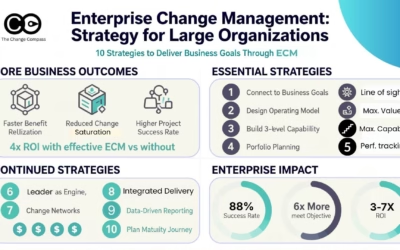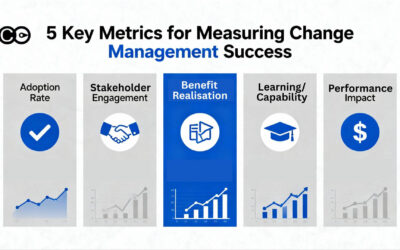Change management professionals often struggle with proving the worth of their services and why they are needed. There are certainly plenty of reasons why change management professionals are required and most experienced project managers and senior leaders would acknowledge this. However, for the less mature organisations that may not have had effective change management experts leading initiatives, the rationale on the additional value of change management may be less clear.
When we look across different project members and project teams, it is easy to argue that without developers, the technical project cannot progress. Without business analysts, we cannot understand and flesh out the core business steps required in the initiative. And of course, we definitely need a project manager for a project. But, what’s the justification for a change manager? Many projects have other project or business representatives do the change work instead.
As an attempt to justify in a very direct way, the value of change management, many resort to ROI calculations and aim toward higher ROI. This ROI of change management may seem like a great way to convey and show in a very direct and financial way, the value of change management towards project success. After all, we use ROI for calculating projects, why not use the same for change management as well to value the people side of change?
There are plenty of articles on how to best calculate change management ROI. Here are a couple:
1. PROSCI
Prosci has a good, clear way of calculating change management ROI within a project (though it doesn’t take into account speed of adoption). You simply evaluate to what extent employee adoption is important to the project. Then you take the overall expected project benefits and deduct the part of the expected benefits if there was no adoption. This is termed “people side benefit contribution”.
People Side Benefit Contribution = Expected Project Benefits – Expected Project Benefits (if adoption and usage = 0)
People Side Benefit Coefficient = People Side Benefit Contribution / Expected Project Benefits
2. Rightpoint
Rightpoint has a variation to this calculation. They have added ELV (Employee Lifetime Value) to the calculation.

(From Rightpoint.com)
“ELV helps account for important (but often overlooked) benefits of change management such as increases in employee productivity, employee retention, and faster ramp-up of new hires. Including the Investment in Change figure ensures that your calculations account for all the hard costs associated with change.” https://www.rightpoint.com/thought/article/measuring-change-management-success-defining-and-ensuring-a-solid-roi
Using ROI may be useful when the cost of the initiative is the critical focus for the organisation for its strategic investment. However, it is not the only way to convey the overall value of successful change management. In addition, the ROI method limits the value of change management to focus on the cost invested versus the value created. Also, this type of calculation limits the value of change to a project by project perspective.

So, how else do we show the direct financial value of change management? Let’s look to research. It turns out there are plenty of research examples. Here are some:
- McKinsey & Company. (2016). The people power of transformations. This study found that transformation initiatives are 5.8 times more successful if CEOs communicate a compelling change story, and 6.3 times more successful when leaders share messages about change efforts with the rest of the organization. Link here.
- Korn Ferry. (2018). Engaging hearts and minds: Preparing for a changing world. This study found that calls out change as a key trend found that companies with high levels of employee engagement had 4.5 times higher revenue growth compared to companies with low levels of engagement, noting that all companies are undergoing change. Link here.
- IBM. (2016). Making change work … while the world keeps changing. This study found that 76% of successful projects include change management activities at the beginning of their overall project plans, which is 33% more than less successful projects. Link here.
- IBM. (2015) Why a business case for change management. The article references a survey carried out in 2010 where companies that apply a value (benefit) realization approach (of which change management is a core component) complete projects at least twice as quickly and under budget by a factor of at least 1.9 times, Compared to those that don’t. Link here.
- Towers Watson. (2013). Change and communication ROI. Organizations with highly effective communication and change management practices are more than twice as likely to significantly outperform their peers in total shareholder returns, versus organizations that are not highly effective in either of these areas. Link here.
- Prosci. (2020). Best Practices in Change Management 11th Edition. The paper referred to a Prosci study that found that projects with excellent change management practices 6 times more likelihood of meeting project objectives than those that are poor. Link here.
So the value the importance of change management, let’s take a comparison to see the difference in using a ROI calculation of the value of change management versus using findings from the above research findings to demonstrate the derived value.
Let’s take a typical project example. Company A has ….
- Annual revenue of $1 billion with 5% profitability
- The revenue growth is 1%
- Project A costs $1Million and is targeted for $3 million in benefits.
If the expected project benefits without adoption would be $1Million, then, the people-side contribution is …
$2Million / $3Million = $667K.
Let’s contrast this to other calculations using research.
Research findings | Calculation
Korn Ferry study where companies with high levels of employee engagement had 4.5 times higher revenue growth compared to companies with low levels of engagement. Taking a very conservative approach of portioning on 1/3 of employee engagement linked to change, this means 1.5 times higher revenue growth. | Taking a very conservative approach of portioning 1/3 of employee engagement as linked to change, this means 1.5 times higher revenue growth. This means if the revenue growth is 1%, then the additional revenue is $15 Million per year.
You can see that $15 million in value is much higher than the $667K in initiative ROI. From these examples, you can see that the financial value dwarfs that from the ROI calculation. On top of this, these are from research findings, which may have a stronger perceived validity and be easier to be trusted by stakeholders than the ROI calculation.
To point out, it is not an apple-to-apple comparison between the change management ROI from one initiative to the organisational value of change management across initiatives. However, the call out is that:
- The financial value of change management does not need to be limited to individual initiatives
- The sum may be greater than its parts. Rather than measuring at initiative levels, research findings are looking at organisational-level value
- The value of change management may be more than cost, but also other value drivers such as revenue
As change management practitioners we should not shy away from calling out and citing the value of change management. Cost may be one value, but the true benefit of change management is both the top line as well as the bottom line. Directly referring to the research-backed findings also helps to highlight its value size and importance.
To do this, we should also work to deliver organisational value in managing change and not limit ourselves to one initiative. Focus on uplifting change management capability in the forms of leadership styles, change governance, change analytics, and change champion network capability, just to name a few.
To read more about calculating the financial value of managing a change portfolio click here.
Have a problem in delivering change using data? Chat with us to find out how Change Compass might be able to help.






